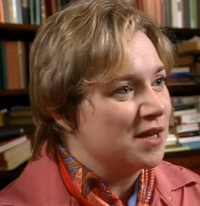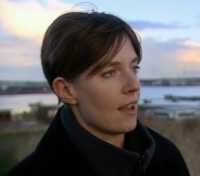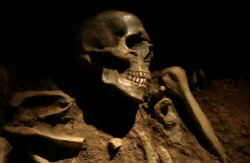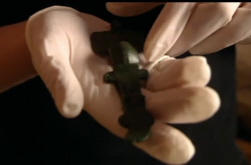Linguistics
Dr Katie Lowe, Dr Sam Lucy
Britain AD: King Arthur’s Britain

Dr Katie Lowe
The people of the 5th century cemetery at West Hesleton look like newcomers from the continent, yet most of them were born in Britain. If this change
wasn’t the result of invasion, what was going on?
There were profound cultural changes in the fifth century. And perhaps the most significant was language. There is no doubt that spoken language changed
from native British known as Celtic – to English, which was a descendant of German. Surely this has to be proof of the Anglo-Saxon invasion. Modern
linguistics, however, are beginning to question this assumption. Katie Lowe has been looking at the traces of native British grammar in
modern English.
Dr Katie Lowe “It’s come down to us that we simply know as a fact that the Celtic languages didn’t affect modern English. And I think that stop people
looking. They just thought there can’t be any influence.”
But linguists have discovered a hidden code in our language structure which shows a strong influence from the Britons.
Katie Lowe “If you’re a Celt and you’re trying to learn old English, just like any second language, you’re going to make mistakes. If you go to
France today you’re bound to make mistakes, mistakes which really show structure from your own language.
For example, you might make mistakes in
syntax, vocabulary, and your accent will be strange. And it’s not some of the Celtic structure affected English.”

Dr Sam Lucy
In the process of learning English, the native Britons retained the structure of their own languages and these ancient patterns are still visible in
the grammatical structure of modern English.
Katie Lowe “Old English was really like German in structure, and the way you constructed a sentence was based largely on endings that indicated
what a word was doing within a sentence. Nowadays word order is all-important. If I say ‘the cat chased the man it does not mean the same the
other way round.”
In German, word endings and not word order would have told us who was chasing who. So why did the English language undergo this strange mutation?
Katie Lowe “We’ve moved, we’ve shifted, to a different kind of word order within a sentence. Where’s that come from? It doesn’t happen as much
within the other Germanic languages. Recent research has shown the Celtic languages had a part to play in this. There has to be contact over
generations. There is no other way of doing it.”
The rise of English in these islands came not from a tidal wave of invaders but from a prolonged period of contact during which the native Britons
chose to adopt a new way of speaking. But why did this happen?
Archaeologist Sam Lucy has been examining graves from the period to understand why this dramatic cultural change took place.
So this would be similar to some of the graves found at West Hesleton?

Skeleton
Sam Lucy “Yep, very similar. Up by his head you got the metal tip of a spear and the wooden shaft has rotted away. You’ve got
down over his hip in metal centre of a wooden and leather shield.”
Just as the language of a native Briton changed in this period, so too did their style of clothes and weapons. At the end of the Roman period a lot
of objects you find had changed. Why was that?
Dr Sam Lucy “It’s traditionally been attributed to Anglo-Saxon migrations or Anglo-Saxon invasions. You do set list that to get a different burial
rites. Women tend to get buried with a much greater variety of dress furnishings. This is known as a cruciform brooch, the cross-shaped brooch, and
this isn’t a continental import. It idea came from the continent but it is a British product. The people living in Britain are aligning themselves to
a continental style and continental ideas, so it’s that process going on rather than population replacement, which is what the traditional idea of
Anglo-Saxon migrations involves.”

Cruciform Brooch
The mistake has been to take cultural artefacts as evidence of racial origin.
Sam Lucy “If I were wearing American jeans, that doesn’t make me American. If I’m driving a German car, that doesn’t make me German. It doesn’t
work like that.”
There can be no doubt that a trickle of warriors and families on the move were coming into Britain from northern Europe in this period, but the
traditional picture of invasion and population replacement are unsustainable. The people of Britain learnt a new language, adopted new fashions and
shifted their political allegiances because they knew from experience that this was the best way to keep up with the changing times. It was only in
later centuries that the complex details of this process were transformed into a captivating story.



